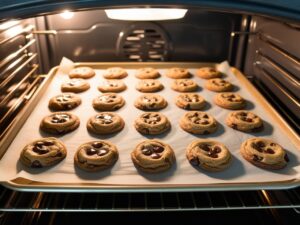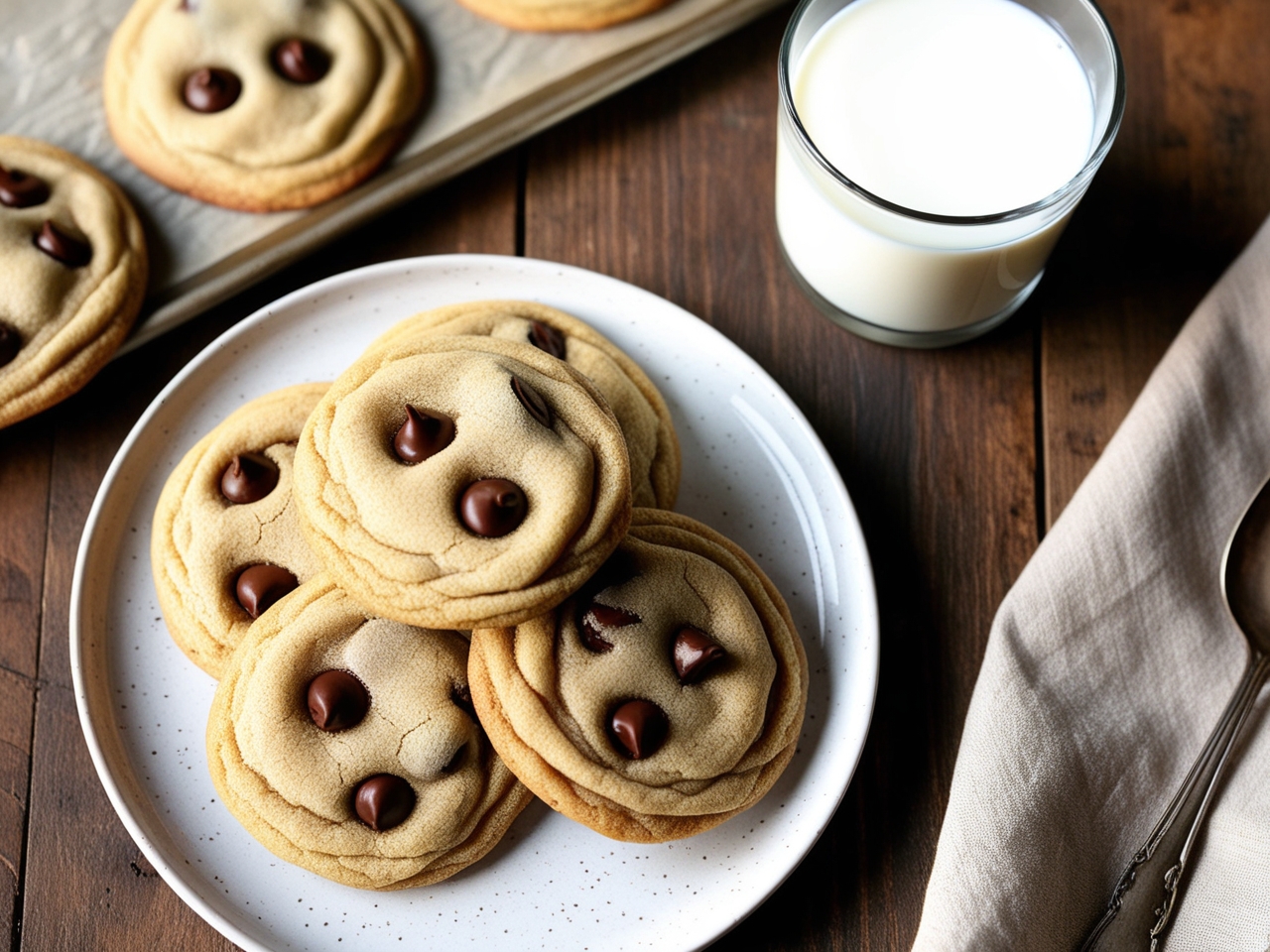When you’re craving a warm, gooey cookie but don’t want to commit to a full batch, small batch chocolate chip cookies are the ultimate solution. These delightful treats let you enjoy fresh-baked cookies without overwhelming your kitchen with leftovers. This article dives into everything you need to know—from selecting ingredients to perfecting your baking technique. Get ready to craft the perfect cookie, tailored just for you!
Understanding Small Batch Chocolate Chip Cookies
Definition and Appeal of Small Batch Chocolate Chip Cookies
Small batch chocolate chip cookies are scaled-down versions of classic cookie recipes, designed to yield a few servings. Whether you’re baking for one, two, or just looking to control portion sizes, these cookies hit the sweet spot. They’re perfect for satisfying cravings without the commitment of larger recipes—and let’s be honest, who doesn’t love fresh-baked goodness with minimal effort?
Historical Background of Small Batch Chocolate Chip Cookies
Though cookies have been a cherished treat for centuries, the concept of small batch baking has gained popularity alongside modern lifestyles. With busy schedules and smaller households, bakers began adapting classic recipes into smaller, more manageable portions. This trend ensures everyone can enjoy homemade desserts without waste.
Essential Ingredients for Small Batch Chocolate Chip Cookies
Core Components
At the heart of any great cookie lies the quality of its ingredients. For small batch chocolate chip cookies, every component plays a crucial role in delivering that signature flavor and texture.
- Flour Types and Their Impact
All-purpose flour is the go-to choice, providing a balanced texture. A hint of bread flour can add chewiness if desired. Avoid cake flour for this recipe—it can make cookies too soft and cakey. - Sugar Varieties: Brown vs. White
A mix of brown and white sugars ensures the perfect balance of sweetness and texture. Brown sugar adds moisture and a caramelized flavor, while white sugar gives the cookies their structure. - Choosing the Right Chocolate Chips
Semi-sweet chocolate chips are a classic choice, but don’t shy away from trying dark or milk chocolate for variety. For a gourmet twist, chop a high-quality chocolate bar for uneven chunks that melt beautifully.
Optional Add-ins and Variations
Customizing small batch chocolate chip cookies is half the fun! Beyond the core ingredients, consider these creative additions:
- Nuts and Dried Fruits
Add walnuts or pecans for crunch, or a handful of dried cranberries for a tart contrast to the sweet chocolate. - Alternative Flavorings
A splash of almond extract or a pinch of cinnamon can elevate your cookies with subtle complexity. - Dietary Substitutions
Need dairy-free options? Replace butter with coconut oil or vegan margarine. For gluten-free cookies, swap in a 1:1 gluten-free flour blend.
Necessary Equipment for Baking
Baking Sheets and Liners
Choose a sturdy baking sheet to prevent uneven cooking. Line it with parchment paper or a silicone baking mat to ensure easy cleanup and prevent sticking.
Mixing Tools: Hand vs. Stand Mixers
A simple hand whisk is sufficient for mixing small batches, but a hand mixer can save time when creaming butter and sugar. Stand mixers are convenient but often unnecessary for smaller recipes.
Measuring Instruments for Accuracy
Precision is key in baking. Use measuring cups for dry ingredients and a digital kitchen scale for even better accuracy.
Cooling Racks and Their Importance
Transfer cookies to a cooling rack immediately after baking. This step prevents overcooking from residual heat on the baking sheet and ensures even cooling for the perfect texture.
Step-by-Step Baking Process
Perfecting small batch chocolate chip cookies begins with mastering the dough preparation and baking techniques. Follow these steps to create cookies that are soft, chewy, and bursting with flavor.
Preparing the Dough

Measuring and Combining Dry Ingredients
Accuracy is critical when baking, and it all starts with the dry ingredients. Measure all-purpose flour carefully using the spoon-and-level method to avoid overpacking. Add baking soda for leavening and a pinch of salt to enhance flavor. Whisk these ingredients together in a small bowl to ensure even distribution before incorporating them into the dough.
Creaming Butter and Sugars
Creaming butter and sugars is the cornerstone of perfect cookie dough. Use softened butter—cold butter won’t blend properly, and melted butter can make cookies greasy. Mix the butter with brown and white sugars until the texture becomes fluffy and the color lightens. This process aerates the mixture, creating a structure that helps the cookies rise during baking.
Incorporating Eggs and Vanilla Extract
Add one egg yolk to the creamed mixture. The yolk provides richness and moisture, perfect for the smaller yield of small batch recipes. Follow this with a splash of pure vanilla extract for an aromatic, sweet flavor that complements the chocolate chips.
Mixing in Chocolate Chips and Add-ins
Fold in semi-sweet chocolate chips using a spatula or spoon, ensuring they’re evenly distributed throughout the dough. If you’ve decided on add-ins like nuts or dried fruit, mix them in at this stage. Overmixing can lead to dense cookies, so fold gently just until incorporated.
Shaping and Baking the Cookies

Portioning Dough for Uniformity
Consistency in size ensures that all cookies bake evenly. Use a small cookie scoop or tablespoon to portion the dough into equal balls. If you like a rustic look, slightly flatten the balls with your fingers or leave them rounded for a puffier shape.
Oven Settings and Baking Times
Preheat your oven to 350°F (175°C)—a reliable temperature for even baking. Line a baking sheet with parchment paper and space the dough balls a couple of inches apart to allow for spreading. Bake for 9–12 minutes, checking often to prevent overbaking.
Indicators of Doneness
The cookies are ready when the edges are golden brown, and the centers appear slightly underbaked. Residual heat will finish cooking them as they cool on the baking sheet. Avoid overbaking, as it can result in dry, hard cookies. If in doubt, it’s better to pull them out early for softer results.
Post-Baking Considerations for Small Batch Chocolate Chip Cookies
Once your small batch chocolate chip cookies emerge from the oven, there are still crucial steps to ensure they maintain their irresistible texture and flavor. Proper cooling, storing, and troubleshooting will make your cookies truly unforgettable.
Cooling and Storing for Small Batch Chocolate Chip Cookies
Proper Cooling Techniques
After baking, transfer the cookies to a cooling rack immediately. Allowing them to cool on the hot baking sheet can cause them to overcook, resulting in harder edges. Cooling racks let air circulate around the cookies, preventing sogginess and ensuring even cooling. If you prefer slightly gooey centers, wait only a few minutes before enjoying your first bite—warm cookies are a special kind of magic!
Storage Methods to Maintain Freshness
Store your cooled cookies in an airtight container to lock in moisture. For soft cookies, place a slice of bread in the container; the bread will release moisture and keep the cookies tender. Refrigeration can extend shelf life but may affect texture, so consider freezing extras if you won’t eat them within a few days. Place parchment paper between layers to prevent sticking when freezing.
Troubleshooting Common Issues
Addressing Spread and Flatness
If your cookies spread too much during baking, it could be due to overly softened butter or an under-measured amount of flour. Next time, chill the dough for 20–30 minutes before baking. This step helps solidify the butter and slows spreading in the oven.
Ensuring Softness and Chewiness
For cookies that lack softness, check your sugar ratios—brown sugar is key to achieving a moist, chewy texture. Overmixing the dough can also make cookies tougher, so mix gently when adding dry ingredients and chocolate chips. Remember, slight underbaking is your ally for soft centers.
Preventing Overbaking
Dry, crumbly cookies often result from too much time in the oven. Keep a close eye on them, especially in the final minutes of baking. Remove the cookies as soon as the edges turn golden and the centers are slightly puffy but not fully set. Residual heat will finish the baking process while maintaining the ideal texture.
Enhancing Your Baking Experience with Small Batch Chocolate Chip Cookies
If you’ve mastered the basics of small batch chocolate chip cookies, it’s time to elevate your baking game. From unique flavor twists to scaling the recipe for different occasions, these enhancements will take your cookies to the next level.
Flavor Variations and Enhancements for Small Batch Chocolate Chip Cookies
Incorporating Different Types of Chocolate
Why stick to just one type of chocolate? Mix semi-sweet chips with dark chocolate chunks for a sophisticated depth of flavor, or add milk chocolate for creamy sweetness. White chocolate pairs beautifully with macadamia nuts, offering a gourmet touch. For a true artisan feel, chop high-quality chocolate bars instead of using pre-made chips.
Adding Spices and Extracts
A pinch of cinnamon or nutmeg can bring warmth to your cookies, while cardamom adds a subtle exotic flair. Extracts like almond or coconut can be used sparingly to complement the vanilla base. Even a drop of peppermint extract can create a festive holiday twist.
Experimenting with Textures
For extra crunch, sprinkle the dough with crushed pretzels or add a topping of flaky sea salt before baking. Swirl in a dollop of peanut butter or Nutella for a gooey surprise. If you prefer a chewy texture, use more brown sugar and reduce baking time slightly for softer results.
Scaling Recipes for Different Yields
Adjusting Ingredient Quantities
Scaling down recipes can be tricky, but doubling or tripling a small batch recipe often works seamlessly. Use a kitchen scale to ensure accuracy, especially for dry ingredients like flour. For odd measurements (e.g., half an egg), whisk the egg first, then use only the required amount.
Maintaining Consistency Across Batches
To keep cookies uniform, mix the dough thoroughly before portioning to ensure even distribution of chocolate chips and other add-ins. Bake one tray at a time, rotating the sheet halfway through, to maintain consistent oven heat. If freezing dough for later use, shape it into portions first for easy baking on demand.
FAQs About Small Batch Chocolate Chip Cookies
Baking small batch chocolate chip cookies is both an art and a science, and it’s natural to have questions about perfecting your results. Here are some common concerns and helpful answers to guide you.
Can I substitute ingredients for dietary restrictions?
Absolutely! Replace butter with coconut oil or vegan margarine for a dairy-free option. For egg-free cookies, use a flax egg (1 tablespoon ground flaxseed + 2.5 tablespoons water) as a substitute. Gluten-free flour blends can replace all-purpose flour in a 1:1 ratio, ensuring everyone can enjoy these treats.
How do I prevent my cookies from spreading too much?
Cookies that spread excessively often have overly soft butter or insufficient flour. Chilling the dough for 20–30 minutes before baking helps firm up the fats, reducing spreading. Additionally, ensure your measurements are precise and avoid overmixing.
What’s the best way to store leftover dough?
Place unused dough in an airtight container or wrap it tightly in plastic wrap. Store it in the fridge for up to 3 days or freeze it for longer storage. For convenience, portion the dough into balls before freezing, so you can bake just a few cookies at a time.
Can I freeze baked Small Batch Chocolate Chip Cookies for later?
Yes, baked cookies freeze wonderfully! Allow them to cool completely, then store them in a freezer-safe bag or container, with parchment paper separating layers. To enjoy, thaw them at room temperature or warm them briefly in the oven for that fresh-baked feel.
How can I make my Small Batch Chocolate Chip Cookies chewier?
For chewier cookies, use a higher ratio of brown sugar to white sugar. Brown sugar’s moisture content helps create that soft, chewy texture. Additionally, avoid overbaking—pull the cookies out when the edges are set but the centers are slightly underdone.
What causes Small Batch Chocolate Chip Cookies to be too cakey?
Excess flour or too much egg can lead to cakey cookies. Ensure your measurements are accurate, and stick to just the yolk in small batch recipes. Using melted butter instead of softened butter can also help prevent a cakier texture.
Mastering Small Batch Chocolate Chip Cookies
Baking small batch chocolate chip cookies is more than just a culinary exercise; it’s a delightful way to enjoy fresh, warm treats without the commitment of a full batch. With a little attention to detail and a willingness to experiment, you can create cookies that suit your preferences perfectly.
Recap of Key Techniques
From selecting high-quality ingredients to chilling the dough and monitoring baking times, every step matters. Use precise measurements, combine sugars for balanced sweetness, and don’t skip the cooling rack for optimal texture. With these techniques, your cookies will be consistently delicious every time.
Encouragement for Experimentation
Don’t be afraid to think outside the box! Try new chocolate combinations, add unique spices, or incorporate fun textures like crushed pretzels or nuts. Adjust ingredients to fit dietary needs and scale the recipe to match your cravings. Baking is a blend of art and science—make it your own and enjoy the process!
Armed with these tips and insights, you’re now ready to bake the best small batch chocolate chip cookies imaginable. Happy baking! 🍪
For another delightful cookie recipe, try our Lemon Blueberry Cookies.

